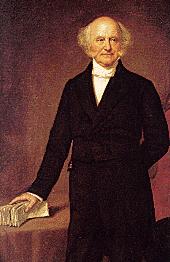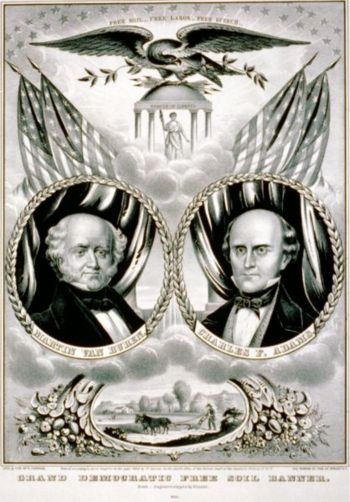Martin Van Buren
Martin Van Buren (1782-1862) was an American politician and President of the United States (1837-1841). From his base in New York state he collaborated with Andrew Jackson to create the new Democratic Party, and directed Jackson's successful presidential campaigns in 1828 and 1832. Van Buren was elected himself in 1836, but was unable to reverse the Depression of 1837, and was defeated for reelection by Whig William Henry Harrison. As a leader of the anti-slavery Democrats who supported the Wilmot Proviso against the expansion of slavery, he founded the Free Soil Party and was its presidential nominee in 1848.
Family
Van Buren was born at Kinderhook, N. Y., on Dec. 5, 1782. He was the third child of Abraham Van Buren, a farmer, tavern owner and political activist, and Maria Hoes Van Buren, both of Dutch stock. Martin was bilingual in Dutch and English, and attended local English schools until he left at age 14 to be a clerk and law apprentice in New York City. Admitted to the bar in 1803, he returned to Kinderhook, where he practiced law until 1821 and gained a reputation as a shrewd politician. In 1807 he married Hannah Hoes, by whom he had four sons before her death in 1819. He did not remarry. Van Buren displayed the qualities of a successful politician. He was able, honest, energetic, imaginative and a glad-hander. A small man, standing no more than five and a half feet (168 cm) tall, he was always impeccably dressed, unruffled, and considerate to friend or foe.
Republican leader
From 1800, when he campaigned for Thomas Jefferson, he remained a resolute Republican. A keen judge of the motives of men, he seldom permitted a difference in politics to interfere with personal friendship. Moreover, he was a middle-of-the-road man, always ready to compromise an issue and at all times ready, as he said, to let the people have what they wanted. He rose rapidly in New York politics, first joining the DeWitt Clinton faction in opposing Aaron Burr and then splitting with Clinton and fighting him for control of the state party. The side-changing gave him a reputation as an ambitious manipulator and was often called "the red fox of Kinderhook." In 1812, Van Buren was elected to the state senate, where he organized and led the "Albany Regency," the anti-Clinton faction. Chosen attorney-general of the state in 1816, he was defeated by the Clinton forces in 1819, but was triumphantly elected to the United States Senate two years later.
In the decades after the War of 1812 increasingly competitive political parties became characterized by greater popular participation and organizational sophistication, in what is called the "Second Party System." Silbey (2002) credits Van Buren the major role in this transformation. He introduced a new level of party organization, unswerving loyalty and recruitment of likely young men as campaigners and candidates, Throughout his career, Silbey contends, Van Buren was "the prime organizer, articulator, and manager of the nation's political conflict."
Because Clinton's followers supported Andrew Jackson for the presidency in 1824, Van Buren aligned himself with the William H. Crawford forces and became their acknowledged leader in the congressional caucus that nominated Crawford. Crawford had a stroke and came in third. In the Senate Van Buren supported the tariff bills but opposed internal improvement measures, possibly affected in this stand by the thought of protecting New York's Erie Canal. Increasingly, however, he became a states' rights man devoted to strict construction views. He was reelected to the Senate in 1827, but resigned to become governor of New York, a position he used briefly to advocate the "safety fund system," which required all banks in the state to insure each other's financial soundness. By 1828 he had changed his political allegiance to Jackson, becoming his confidential political adviser and in 1828 managing his election campaign in the northeast. Van Buren was rewarded as secretary of state. Once within the official family, Van Buren seemingly bent all of his efforts to strengthening his position and weakening that of Vice president John C. Calhoun, who, it was thought, would succeed Jackson in 1832. Carefully avoiding any conflicts with Jackson's close friends in the "Kitchen Cabinet," he became one of the most reliable supporters of the president. When Peggy Eaton, wife of the secretary of war, was ostracized by senior officials (on rumors she once was a prostitute), Jackson supported Eaton and Van Buren went out of his way to befriend her. He vigorously supporting Jackson in trying to destroy the Second Bank of the United States, over the opposition of the business community. Van Buren helped Jackson by obtaining the New York legislature’s official endorsement of Jackson’s stern warnings against South Carolina in the nullification affair. By 1831 Jackson made it clear that Van Buren would be his vice-presidential running mate in 1832. Appointed minister to the Court of St. James (i.e. ambassador to Britain) in 1831, Van Buren arrived in that country only to find that Calhoun had blocked his confirmation in the Senate. During the next year he made a tour of Europe and returned to the States after he had been nominated for the vice-presidency. He was elected with Jackson, who defeated Whig Party candidate Henry Clay.
President 1837-1841
Both as secretary of state and as the presiding officer of the Senate he acquitted himself with skill and honor, and with Jackson squarely supporting him, he was nominated by his party for the presidency in 1836.
During his 1836 presidential campaign Van Buren promised to continue Jackson's policies and won easily over Daniel Webster, William Henry Harrison, and H. L. White, the regional Whig candidates.
Van Buren in office continued his party's opposition to the Bank by proposing a plan for an independent treasury in which the Government could keep its funds. Although there was strong opposition to the plan, a subtreasury bill was passed in 1840. Long before his election, the president had had to commit himself on the slavery issue. He was opposed to the extension of slavery although he had promised to protect it where it existed. Accordingly he opposed the plan to abolish slavery in the District of Columbia. On the other hand, he refused to support the plan to annex Texas, which would have created more slave territory and would probably have meant a war with Mexico. He also preserved strict neutrality during Canada's revolt against Britain in 1837, an action that was heartily criticized by the strong anti-British faction in the country.
The most difficult challenge involved those connected with the financial panic of 1837 and the depression that followed. Just as he took office in March 1837 the nation's banks began to suspend specie (gold) payment. For the next three years unemployment, crop failures, and extremely low prices created real distress throughout the nation. Banks closed their doors, states were unable to meet their financial obligations, and many workingmen in the eastern cities were without jobs and hungry. Since the prevailing economic thought of the period held that the government should abstain from interfering with the country's economic life, Van Buren did nothing to alleviate the effects of the depression.
Against this background of discontent and suffering he was renominated in 1840 to run against the Whig candidate, William Henry Harrison. In the campaign that followed, characterized as "a Northern man with Southern principles," a cold aristocrat indifferent to the people's sufferings, he was decisively beaten.
Free Soil candidate in 1848
Retiring to Kinderhook, Van Buren in 1841, took up the life of a gentleman farmer. Van Buren took a great interest in his farm, supervising workers and utilizing "progressive" farming techniques. Van Buren embraced the genteel lifestyle but made it his own with his enthusiasm, profit-mindedness, and bourgeois calculation. He was still politically ambitious, and during the next four years worked for the 1844 nomination. His equivocal position on slavery and Texas, made known by the famous "Hammet Letter," hurt his chances considerably. In the following convention, although he had a majority of the delegates, he was unable to obtain the necessary two thirds and lost to James K. Polk, who was elected.
In 1848, the Mexican-American War had intensified the slavery issue. Advocates of the Wilmot Proviso tried to block slavery in new territories acquired from Mexico. They joined the "Barnburner" faction of New York Democrats and formed the new Free Soil Party, whose convention in Buffalo drew 465 delegates from 18 states. With Charles Francis Adams as his running mate, the new anti-slavery party stood for the Wilmot Proviso. He won 291,000 votes, half of them in New York. By splitting the Democrats in New York, his new party allowed Whig Zachary Taylor to win. Van Buren split with the Free Soilers when he supported the Compromise of 1850. He grew fearful that the slavery issue would disrupt the Union. Neither an abolitionist nor a slavery man, he supported James Buchanan in 1856 in the hope of compromise. When war broke out he became a sincere supporter of Lincoln. He died at Kinderhook, July 24, 1862.
Further reading
For a more detailed guide see the Bibliography tab.
- Donald B. Cole. Martin Van Buren and the American Political System (1984),
- James C. Curtis. The Fox at Bay: Martin Van Buren and the Presidency, 1837-1841 (1970),
- John Niven. Martin Van Buren: The Romantic Age of American Politics (1983)
- Robert Remini. Martin Van Buren and the Making of the Democratic Party (1959). online edition
- Silbey, Joel H. Martin Van Buren and the Emergence of American Popular Politics. 2002. 237 pp. online review
- Major Wilson. The Presidency of Martin Van Buren (1984),
See also
- American election campaigns, 19th century
- Free Soil Party
- U.S. Democratic Party, history
- Second Party System
- Whig Party
External links
- American Political History Online links
- Michael Holt, The Second American Party System, short topical essays

